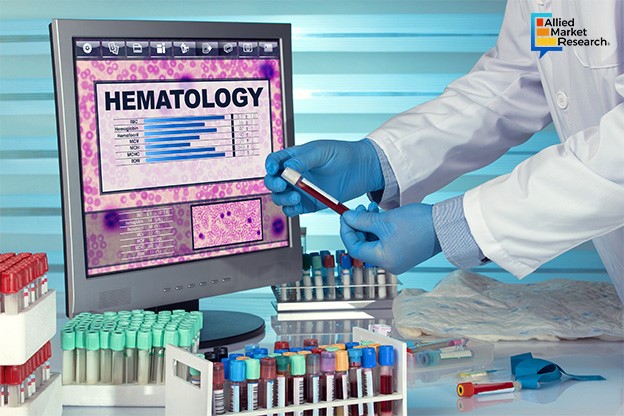Why Should Medical Device Businesses Adopt Advanced Hematology Diagnostics Technologies?

29 Feb
2024
Highlights:
- Introduction
- Potential of hematology analyzers
- AI-based hematology analyzers
- Role of automation and digitalization in advancing the sector
- Frontrunner's tactics
Hematology tests identify various blood disorders and diseases, including conditions such as inflammation, anemia, infections, clotting abnormalities, leukemia, and reactions to chemotherapy. Blood-related disorders, such as leukemia, thrombocytopenia, anemia, hemophilia, and various other hematological conditions, have impacted millions of individuals across the globe.
The increased prevalence of these disorders is due to factors such as rise in geriatric population, shift in lifestyle, genetic predispositions, and environmental influences, which drives demand for hematological testing within healthcare systems.
Hematological diagnostics is a branch of medical diagnostics that focuses on examining and analyzing blood and its constituents to diagnose and monitor various blood disorders. This includes conditions such as anemia, leukemia, clotting disorders, and immune system disorders. The global hematology diagnostics industry is expected to manifest a notable CAGR of 4.4% by 2032.
Hematology Analyzers: A vital component in diagnostics
The number of tests carried out at the same time in a single operation of hematology analyzers significantly reduces labor requirements and waiting times. These analyzers offer more accurate results than manual testing.
- Minimized operational costs and TAT (turnaround time):
By optimizing sample processing, reagent consumption, and waste management, hematological analyzers have decreased the TAT of testing and operating expenditure. For instance, Mindray's CAL 8000 Cellular Analysis Line processes multiple samples simultaneously with minimal manual intervention. This has led to a substantial reduction in Turnaround Time (TAT) by up to 50%. Moreover, it incorporates a closed tube sampling system, which minimizes reagent usage and exposure to biohazards.
- Enhanced efficiency and precision:
Hematology analyzers have enhanced their accuracy, precision, and efficiency through the integration of advanced technologies, including digital imaging analysis, artificial intelligence (AI), and cloud computing. These innovations enable the analyzers to capture high-resolution images of blood cells, employ intelligent algorithms for analysis, and store the data in cloud databases. This allows remote access and supports quality control measures.
AI-based hematology analyzer: an advanced and accurate diagnostic method
The rise in volume of information generated by hematology analyzers imposes a significant workload on clinicians. This increases the possibility of negligence of critical information.
Advanced hematology analyzers incorporate artificial intelligence (AI) analysis to generate easily interpretable information. This advancement plays a vital role in decreasing turnaround time, minimizing technical misclassifications, and reducing the workload of clinicians.
For instance, the recently developed DH-615 hematology analyzer by Dymind Biotechnology Co., Ltd. in Shenzhen, China, uses fluorescent nucleic acid staining technology and the company's proprietary AI Cube technology. This unique combination significantly enhances the identification of abnormal cells. In addition, it improves the analyzer's capability to diagnose hematological diseases, such as leukemia and anemia.
The AI Cube technology simplifies complex information into a readable format for disease analysis, in comparison with standard flag alarm functions, which provide only definitive data. The DH-615 hematology analyzer offers clear and intuitive graphics, showcasing the normal parameters and varying degrees of corresponding diseases for reference by using AI.
Automation and digitalization have changed the landscape of the hematology diagnostics sector
A visible trend in hematology diagnostics is the automation of the test processes that reduces testing time with a combination of advanced analyzers. Fully automated systems minimize manual intervention, enhance efficiency, and contribute to quicker turnaround times for hematological testing. The automated systems have addressed the demand for high-throughput diagnostics in clinical laboratories.
The hematology diagnostics industry has undergone a transition toward high-sensitivity testing methods. These methods enable the detection of the latest changes in blood parameters. This trend is important for the early diagnosis and monitoring of conditions such as leukemia and anemia, where discrete variations in blood cell counts indicate disease progression or treatment effectiveness.
Point-of-care (POC) hematology testing has become increasingly popular as it provides rapid and decentralized diagnostic solutions. Compact and portable hematology analyzers enable rapid on-site testing, particularly in emergency departments and mobile care settings. POC testing enhances diagnostic speed and enables detailed clinical interventions.
However, digitalization has transformed hematology diagnostics and incorporated advanced connectivity options in analyzers. Integration with laboratory information systems (LIS) and electronic health records (EHR) streamlines data management and communication between diagnostic devices & healthcare facilities. This integration contributes to enhanced workflow efficiency.
Understanding the competitive scenario of the hematology diagnostics industry
The global hematology diagnostics industry has gained popularity due to a rise in the adoption of point-of-care testing, a surge in awareness of health & screening programs, and an increase in the prevalence of chronic conditions. Frontrunners in the sector have adopted novel strategies, such as mergers, collaborations, and new product launches, to sustain the competitive industry.
For instance, on February 4, 2024, the prominent diagnostic technology brand in India, Agape, announced the launch of its first domestically manufactured HX series hematology equipment and Mispa i200 Immunology CLIA analyzer. This launch marked a significant milestone in a new diagnostics era.
With this latest innovation in India, the machines now have the potential to revolutionize laboratory work by automating blood tests with unparalleled speed and accuracy. They are designed to offer comprehensive health information and allow diagnosis of different conditions through blood counts, hemoglobin, platelet counts, and other essential tests.
Moreover, on January 30, 2024, Agilent Technologies announced its collaboration with Incyte for the development of CDx (companion diagnostics) programs. The primary objective of the collaboration is to support Incyte's portfolio in oncology and hematology.
To conclude, the global hematology diagnostics industry has gained momentum due to a rise in the adoption of point-of-care testing, a surge in awareness of health & screening programs, and an increase in the prevalence of chronic conditions. However, advanced technologies in hematology analyzers are expected to offer remunerative growth opportunities to the industry in the upcoming years.
For detailed analysis of competitive scenarios, segmentation, and regional analysis of the hematology diagnostics industry, contact our experts today!

Akhilesh Prabhugaonkar
Author's Bio- Akhilesh Prabhugaonkar holds a bachelor’s degree in Electronics Engineering from the reputed Vishwakarma Institute of Technology. He has a special interest in the fields of forensics, world history, international relations and foreign policy, sports, agriculture, astronomy, security, and oceanography. An ardent bibliophile and melophile, Akhilesh loves to write on topics of his interest and various other societal issues. This love for writing made him enter the professional world of content writing and pursue his career in this direction.
Avenue: Entire Library membership of Allied Market Research Reports at your disposal
- Avenue is an innovative subscription-based online report database.
- Avail an online access to the entire library of syndicated reports on more than 2,000 niche industries and company profiles on more than 12,000 firms across 11 domains.
- A cost-effective model tailored for entrepreneurs, investors, and students & researchers at universities.
- Request customizations, suggest new reports, and avail analyst support as per your requirements.
- Get an access to the library of reports at any time from any device and anywhere.
Related Post
-
How are Submarine Cables Transforming Global Connectivity with Enhanced User Experience?
-
Endoscopy Procedures: Transformations in Techniques and Applications
-
AI-Powered Video Analytics: How the Product Actually Works for enterprises
-
Painting Robots: Transforming Precision Coating and Creative Applications
-
Innovations in Pharmacovigilance Systems Advancing Patient Safety
-
Understanding Edge Security: Keeping Data Safe Near the Source
-
Exploring the Use and Advancements of 3D Laser Scanners in Professional Applications
-
Reinforcing Industrial Controls with Smarter Tools and Training








